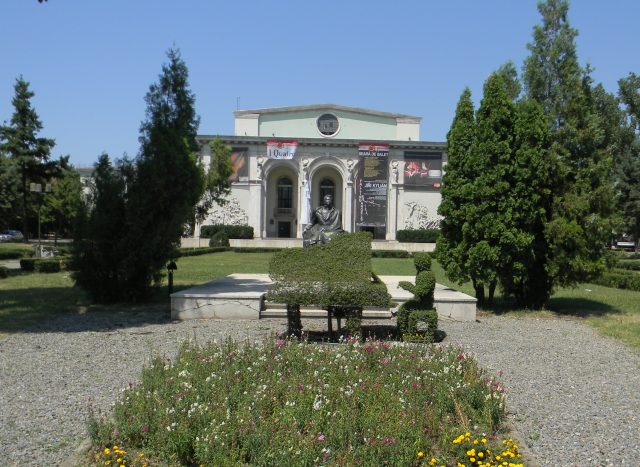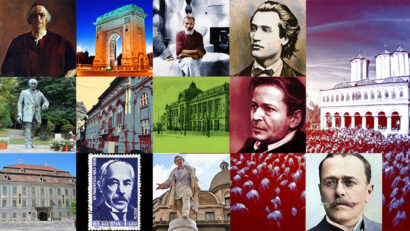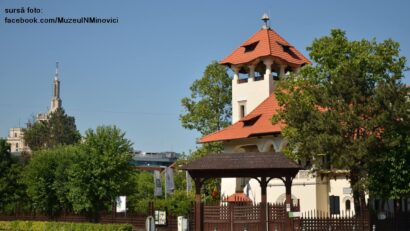The Romanian Opera House Palace in Bucharest
The History of the Romanian Opera House building

Radio România Internațional, 06.04.2024, 14:00
Composer and conductor George Stephanescu in late 19th century established Romania’s first opera troupe, then known as The Romanian Lyrical Company, arguably the nucleus of lyrical theater in Romania.
Notwithstanding, from its establishment and to the early 1950s, the Romanian Opera House did not have its own premises: its performances were venued by other theaters in Bucharest.
The situation would change in the early days of the communist regime, mainly for propagandistic reasons. In 1953, Bucharest played host to a great international youth festival, and that was the reason why a string of buildings appeared in the capital city, with the purpose of playing host to all the events scheduled back then. Among these buildings there was the present-day building of the Romanian National Opera House. They were located on Dambovita river banks, quite close to the imposing building of the Law Faculty.
And, despite the fact that this new palace had been designed to comply with the architectural pattern of the Soviet buildings, just as it happened with the Casa Scanteii building, the Romanian Opera House vaguely reminds us of that style.
A recently-published work provides a detailed analysis of the stages of the construction as well as the aspect of the Opera House palace. The title of the work is “The History of the Bucharest Opera House building.” Its author is the Director of the Academy Library, Nicolae Noica.
Here is the author himself, reminiscing about the history of the building:
“The Opera House had been created by a great man of culture, George Stephănescu. Afterwards, for a good number of years, until 1952, with no premises of its own, it was housed by a building near the Cismigiu Park, and then, for a long time, it was housed by the National Theater building on Victoria Road. Unfortunately, the National Theater was shelled. I was baffled to find out, researching documents dated 1948-1949, that the one who had the first initiative to build an Opera building was doctor Petru Groza, the head of the Romanian Government. And then, through a government resolution, he offered a plot of land where today’s National Theater Building in the center lies, close to the University. He organized a competition, yet nothing was materialized. However, around 1950-1951 a resolute decision was taken and the Bucharest Project Institute, which was established at that time, was officially empowered to draw up the project. The respective project was coordinated and thought out by a great architect: professor Octav Doicescu. He was a man of the old school who had also represented us in a couple of international exhibitions between the wars, jointly with our great architects Petre Antonescu and G.M. Cantacuzino. Of course, first and foremost, the top priority was to pick the plot where the building would be erected and a place was spotted on the quay, right where the building of the Opera House lies today. An official stadium used to be there, at that time. The project was drawn up, just as I said, by architect Octav Doicescu and the works began in 1951 or thereabouts.
But what was the selected architectural style and how was that done?
Here is academician Nicolae Noica once again:
“It has been often said that is has that aspect of the Russian or Soviet buildings. However, Octav Doicescu did not do something like that, but for the project to get through after the checks that had been made, the original sheets were signed by a Russian advisor, for the confirmation of the solutions. Then again, the Russian architects who had come here had a special consideration for Octav Doicescu, and for Macovei, and they allowed for a whole range of elements to get through so that the building could a monumental one and offer the initially envisaged image. Yet speaking about the style, I can say it is a Romanian style, with a string of elements that were borrowed, yet in no way is it true what was said about it, that it was a building following the pattern of the buildings in Moscow at that time. ”
For the construction of the Romanian Opera Palace, Octav Doicescu teamed up with architect Pompiliu Macovei, the coordinator of the construction yard, and the Armenian-born construction engineer Aznavurian. The construction was completed in 1953, while the official inauguration was held in January 1954, with a performance of Tchaikovsky’s The Queen of Spades.
The façade of the building, changed as compared to the architect’s initial idea, has a porch with three monumental arcades supported by columns on which heads we can find the statues of four muses. Also, there are three access doors facilitating the entrance to the imposing hall, elevated on two floors. It is also the façade that is adorned with bas-reliefs made by sculptors Zoe Băicoianu, Boris Caragea and Ion Vlad.
About the interior decoration, here is Nicolae Noica once again.
“There is this foyer inside, which is splendid and somewhere to the left, when you climb up the stairs, there is the yellow salon: a beauty in itself, with a whole range of decorations made back then, in the year 1953, and preserved in spectacularly mint condition to this day. In the performance hall you find the lodges divided with little pillars for partition. Of course, at this point there was so much talk about it as well. If these little pillars do not bother from an architectural point of view, they had been imposed taking the resistance of the building into account. Also, the ceiling is splendid, made of carved wood, and, what is most impressive, the old chandelier with 100 bulbs is still there. Also, at that time a heating and a ventilation installation were made there, so they could create the appropriate climate. Unfortunately, years went by and this installation does not work perfectly. We also spoke with Mrs. Minister of Culture to support us financially, so much so that these works may live up to the present-day’s fair and modern standards, since it is our responsibility, 70 years on, to be able to preserve the building.
Actually, from the very beginning The Romania Opera Palace was designed to be resistant. In the wake of the 1977 and 1986 tremors, not a single crack was reported to have damaged its walls.





























